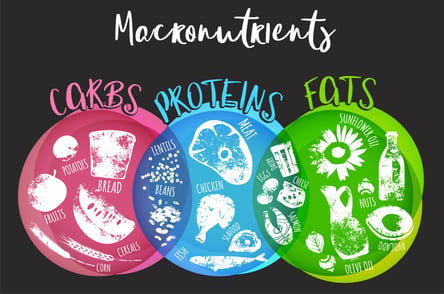 A diet that is balanced in its macronutrient distribution can help reduce the risk of disease and help with lasting weight loss. You might have heard of others tracking their “macros” and wondered if this is something that you need to do. So, why and how do you do this tracking?
A diet that is balanced in its macronutrient distribution can help reduce the risk of disease and help with lasting weight loss. You might have heard of others tracking their “macros” and wondered if this is something that you need to do. So, why and how do you do this tracking?
What Are Macronutrients?
The major macronutrients are protein, carbohydrates, and fat. All are essential to health and well-being. Since 1941, the National Academy of Sciences (NAS) has reviewed the latest science and pulled together a group of experts to make recommendations to the public. The latest recommendations were published in 2005. Some foods provide a mix of macronutrients (beans provide protein, carbohydrates, and sometimes a very small amount of fat), while others provide only one type of macronutrient (olive oil provides just fat). Whether they are a mix of macros or one type, they all serve a purpose.
Protein
Protein provides four calories per gram. Protein is vital for immune function, building and repairing tissue, cell signaling, hormones, and enzymes. Protein-rich foods include eggs, poultry, fish, tofu, lentils, and beans.
Carbohydrates
Carbohydrates provide four calories per gram as well. In your body, carbohydrates are broken down into glucose, a type of sugar that your body uses for immediate energy or stores in your liver and muscle for later use. Carbohydrates are found in almost all foods with the exception of oils/fats and meat—items like grains, starchy veggies, beans, dairy, and fruit contain carbohydrates.
Fat
Fat has the most calories at 9 calories per gram. Your body needs fat for energy, hormone production, and nutrient absorption. Fat is found in oils, butter, nuts, meat, and fatty fish.
What Is an Acceptable Distribution of Macronutrients?
The Acceptable Macronutrient Distribution Range (AMDR) is the range associated with reduced risk for chronic diseases while providing essential nutrients like vitamins and minerals. NAS has classified the following AMDR for adults as a percentage of calories as follows:
Protein: 10–35%
Fat: 20–35%
Carbohydrates: 45–65%
For example, an individual consuming 2,000 total calories per day will aim for approximately:
2,000 calories x 10 to 35% = 200–700 calories from protein OR 200–700 calories / 4 calories per gram = 50–175 grams of protein
2,000 calories x 20–35% = 400–700 calories from fat OR 400–700 calories / 9 calories per gram = 44–78 grams of fat
2,000 calories x 45–65% = 900–1300 calories from carbohydrates OR 900–1300 calories / 4 calories per gram = 225–325 grams of carbohydrates
How to Track Macros
- Determine your calorie needs (many formulas online, RMR testing at NIFS, and various apps will create calorie recommendations as well).
- Determine your macronutrient breakdown ( for example, if you’re very active, you may need more carbohydrates and protein).
- Log food intake into a journal like My Fitness Pal, Lose It, or My Macros+ app.
Keep in mind you might not always hit your goals precisely and the tools we have to calculate calories are not perfect. Food tracking is great for helping you get closer to your goals; but our bodies are not calculators, so give yourself a little “wiggle room” in your tracking.
Benefits of Tracking Macros
- Improves diet quality: Instead of focusing on calories, where a bowl of oatmeal with nuts and fruit may be equal to a bowl of Lucky Charms cereal, you will focus on nutrients.
- Helps with weight loss: Those who track food tend to lose more weight than those who do not track food intake.
- Helps with specific goals: Those who are endurance athletes may need more carbohydrates than athletes who are lifting weights multiple times per week.
When Is Tracking Useful?
Those who thrive on structure may find tracking macronutrients to be something they enjoy, and very beneficial. It can help to increase your awareness of the quality of foods you are eating and the amount of healthy foods you are eating. (Those with a history of disordered eating should not track food intake.)
When first starting, you may find it overwhelming, but over time you find the foods and healthy eating patterns that help you hit your macronutrient goals. When tracking macronutrients, it is important to focus on a mainly whole-foods diet that emphasizes fruits and vegetables, healthy fats, complex carbohydrates, and protein. The benefits come from making adjustments as needed—not finding the perfect ratio from the very beginning. Many can eat a well-balanced diet without tracking intake—there is no one-size-fits-all plan—but rest assured: if most of your food was grown in the ground and everything else is included in moderation, you are giving your body just what it needs.
Contact Lindsey Hehman, RD, at lhehman@nifs.org for questions or to come up with more specific macronutrient goals.
This blog was written by Lindsey Hehman, MA, RD, CD. To learn more about the NIFS bloggers, click here.

